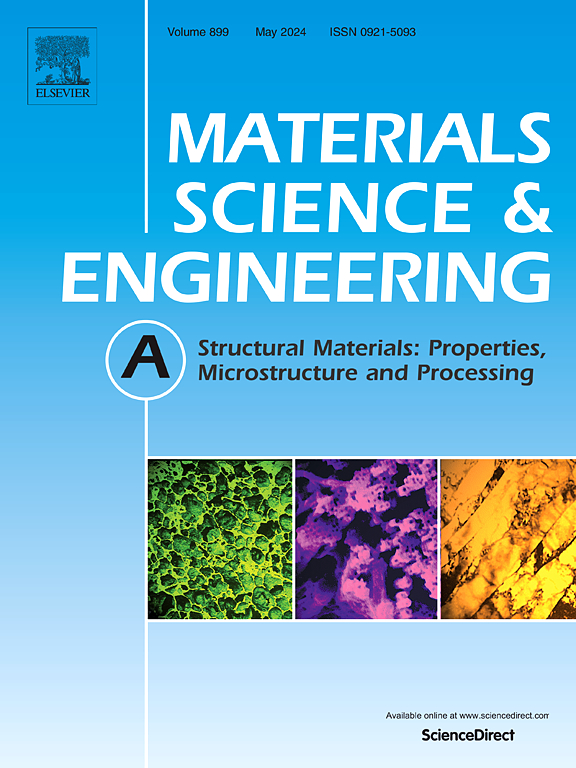激光粉末床熔合Al-4Mn-3Ni-2Cu-1Zr铝合金显微组织对高温塑性的影响
IF 7
2区 材料科学
Q1 MATERIALS SCIENCE, MULTIDISCIPLINARY
引用次数: 0
摘要
针对LB-PBF设计了一种新型Al-4Mn-3Ni-2Cu-1Zr (wt%)铝合金,在应力解除状态(4h/300°C)下,通过在100°C至350°C的不同应变速率(10-2 s-1至10-5 s-1)下进行拉伸试验,评估了其高温力学性能。当温度为>;150°C时,应变率降低,塑性降低。微观结构在多个尺度上高度不均匀。在晶粒尺度上,熔池边界附近由亚微米细等轴晶(FZ)组成,而熔池内部由粗柱状晶(CZ)组成。显微组织中还含有大量的金属间颗粒(约20%)。它们的形态、大小和空间分布取决于感兴趣的区域(FZ或CZ)。利用扫描电镜和透射电镜对变形和断裂试样进行了多尺度显微组织分析,研究了损伤机制,并确定了FZ和CZ区域的主要变形机制。无论温度在100 ~ 350℃之间,FZ和CZ区域都在高应变速率下因位错蠕变而变形。从150°C到350°C, FZ的变形机制发生变化,从高应变速率下的位错蠕变(对晶粒尺寸不敏感)到低应变速率下的晶界滑动(对晶粒尺寸敏感)。这种低应变速率下FZ变形机制的改变导致了早期应变局部化和损伤发展。同时,CZ仍处于位错蠕变控制下。因此,在温度>;150°C时,低应变速率下,FZ和CZ的机械响应之间的对比增加。本文章由计算机程序翻译,如有差异,请以英文原文为准。
Influence of the microstructure on the high temperature ductility of the Al-4Mn-3Ni-2Cu-1Zr aluminium alloy designed for laser powder bed fusion
The elevated-temperature mechanical properties of a new Al-4Mn-3Ni-2Cu-1Zr (wt%) aluminium alloy designed for LB-PBF in its stress-relieved condition (4h/300 °C), were evaluated using tensile tests conducted from 100 °C up to 350 °C at different strain rates ranging from 10-2 s-1 to 10-5 s-1. The ductility decreases when decreasing strain rates for temperatures >150 °C. The microstructure is highly heterogeneous across multiple scales. At the grain scale, regions near the melt pool boundaries consist of submicron fine equiaxed grains (FZ) while coarser columnar grains (CZ) are found in the melt pool interiors. The microstructure is also decorated by a large fraction of intermetallic particles (about 20 %). Their morphology, size, and spatial distribution depend on the region of interest (FZ or CZ). Based on a multi-scale microstructural analysis of the deformed and fractured specimens using scanning and transmission electron microscopy, we investigate the damage mechanisms and identify the main deformation mechanisms operating in the FZ and CZ regions. Regardless of the temperature between 100 and 350 °C, both regions FZ and CZ deform by dislocation creep at high strain rates. From 150 °C up to 350 °C, the FZ is subjected to a change in deformation mechanism from dislocation creep at high strain rate (insensitive to grain size) to grain boundary sliding (sensitive to grain size) at low strain rate. This change in deformation mechanism of the FZ at low strain rates leads to early strain localization and damage development. At the same time, the CZ remains in a regime governed by dislocation creep. Thus, the contrast between the mechanical response in the FZ and CZ increases for temperatures >150 °C at low strain rates.
求助全文
通过发布文献求助,成功后即可免费获取论文全文。
去求助
来源期刊

Materials Science and Engineering: A
工程技术-材料科学:综合
CiteScore
11.50
自引率
15.60%
发文量
1811
审稿时长
31 days
期刊介绍:
Materials Science and Engineering A provides an international medium for the publication of theoretical and experimental studies related to the load-bearing capacity of materials as influenced by their basic properties, processing history, microstructure and operating environment. Appropriate submissions to Materials Science and Engineering A should include scientific and/or engineering factors which affect the microstructure - strength relationships of materials and report the changes to mechanical behavior.
 求助内容:
求助内容: 应助结果提醒方式:
应助结果提醒方式:


